Photo: Cheese Companions trios at the Boston Christmas Festival
If your specialty food makes for an attractive gift, it can bring significant sales to your online store and at Christmas festivals. But your small business may not experience the success that you hope for if you don’t choose the right festivals, the right products to display, and if your booth display is not presenting your company in its “best light.” In 2017, we exhibited at Boston Christmas Festival (now called the New England Christmas Festival) with our Cheese Companions. Over three days, our sales were $4,700 which represented 16% of our annual sales. It is far from being insignificant, but it is crucial to understand what it took to make it happen. Here are 26 tips on how to be successful in selling specialty food at a Christmas festival.
Note that some tips from our Fancy Food Show article are valuable here as well, but Christmas Festivals are different because you sell actual products! Let’s see how you can maximize your success!
A. Selecting Christmas Festivals
The first thing you must do is to select the right festivals.
-
Make an inventory of Christmas Festivals and understand costs and conditions to exhibit
There are probably several Christmas Festivals in your region over a few weeks. Some may restrict who can exhibit (e.g., local businesses), or the number of exhibitors by type of products. Some happen on conflicting dates. Costs vary drastically from one festival to another and are based on different criteria (fixed cost, cost per square foot, options for floors, or add-ons such as electricity, carpet, furniture, etc.). We recommend creating a table with all this information, to have a clear vision of the options, the total costs, and make the right decision.
-
Talk to other exhibitors to understand attendance, sales, and sampling needs
We found it extremely valuable to talk to past exhibitors to get a better idea of the potential of the show, in terms of attendance and sales, the type of attendees, the number of samples we needed. Without such understanding, it is nearly impossible to forecast a Profit & Loss (P&L) for each festival.
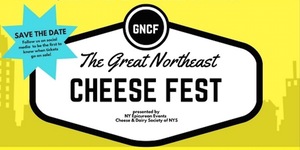 As an example, we attended two shows in December 2017: The Great Northeast Cheese Festival in NYC and the Boston Christmas Festival. But the NYC festival took place on a Saturday evening. Attendees bought tickets and were only interested in having a good time, drinking, and sampling products. Not a great environment to sell Christmas gifts. On the contrary, the Boston Christmas Festival is a well-known 3-day event where people come with the only purpose of doing their Christmas shopping.
As an example, we attended two shows in December 2017: The Great Northeast Cheese Festival in NYC and the Boston Christmas Festival. But the NYC festival took place on a Saturday evening. Attendees bought tickets and were only interested in having a good time, drinking, and sampling products. Not a great environment to sell Christmas gifts. On the contrary, the Boston Christmas Festival is a well-known 3-day event where people come with the only purpose of doing their Christmas shopping.
-
Book space well in advance
For some popular shows, you may need to book as much as one year in advance. Planning well ahead is key.
B. Preparing Your Show P&L (revenues and costs)
Next, you must make sure that the potential to make money is real.
-
Estimate the show’s total costs
What you pay the festival organizer is only part of your costs. Costs will vary depending on the location (yes, lodging in Boston for three days, with parking, is expensive!), the distance from where you live (gas and rental of a trailer). Costs also include printed literature, samples, labor, and of course, your display unit.
-
Review product sales and margin
First, you need to know who are your top sellers and your highest margin products.
-
Forecast the festival’s revenues and costs (P&L)
Then you should list all your costs and estimate your product sales to forecast your profit for the event. If you are forecasting a loss, it’s time to revise or reconsider your plan! An Excel sheet is a good tool. And we’ll show you in part D of this article how to select the products to exhibit.
-
Partner with other specialty food manufacturers
You can help your costs by partnering with other businesses for your product sampling. In exchange, you can distribute their promo coupons and share their literature. For our Cheese Companions, we partnered with manufacturers of crackers and cheese. We developed excellent long-term relationships with them.
C. Branding and Marketing for the Show
Branding principles apply here as well, just as much as when you design your packaging or your website.
-
Grab the visitors’ attention
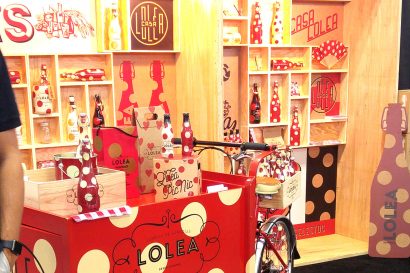 Here is a photo I took at the Summer Fancy Food Show in New York. That booth definitely grabbed my attention!
Here is a photo I took at the Summer Fancy Food Show in New York. That booth definitely grabbed my attention!
If you ever attended shows, you’ve quickly realized that a lot of exhibitors don’t even get your attention. Their display is dull and not well lit. Their signage is too busy and unattractive.
It’s valuable to attend shows yourself. Observe what is grabbing your attention and try to see what sells the best.
Everyone competes for attention. Get yourself noticed!
-
What makes you unique – how can you help
That’s branding 101: make sure that visitors quickly understand how unique you are and how you can help them.
-
Design attractive display units and signage
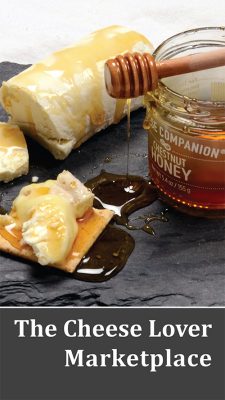
Pinterest is an excellent place for inspiration. Preparing for the show, we had gathered some ideas (see our Pinterest booths & displays folder here .) Of course, your display’s “look and feel” depends on your branding and on the type of products you sell.
Grab the attention, have a clear brand message, show off your products clearly, have price tags, feature your “festival special”: these are all the things to remember when designing your booth display and signage.
-
Plan your product literature well
I have a personal bias: I believe that most literature will end up in the garbage within 24 hours. So I am not in favor of expensive brochures and pamphlets. However, discount coupons with your website address (URL) to encourage people to go and buy from your online store later, as well as business cards, are good options.
-
Have a “festival special” and sell NOW
Experience taught us that most of the people who tell you “I’ll come back later in the day” or “I’ll buy online later” simply don’t. So don’t hope for future sales and do everything you can to sell now. That’s why a “festival special” deal as an incentive to buy immediately is an excellent tactic. Everyone knows it!
As an example, a couple of years ago, at a food show, I bought that divine box of praline chocolates, so delicious and so unique. I saved the label to buy some online later, but the fact is that I still have not purchased any, even though I LOVE them! There is nothing like the present moment for a spontaneous purchase.
D. The Booth Display
At this point, you’ve decided on a booth design and display units, in harmony with your branding. It’s time to choose all the elements of your booth and select precisely which products you’ll sell and how you’ll display them.
-
Map your space and choose tables, shelves, and chairs
It may seem obvious, but drawing your space and precisely positioning everything you need to bring, including coolers for refrigerated samples, extra inventory, wrapping paper, cashier, shelves, tables, and chairs, is of the highest importance. Choose high chairs, so you can rest your legs while being at eye-level with customers stopping by.
-
Light your display well
If you observed other booths, you must have noticed the impact of a well-lit booth. Make sure that your lighting highlights your signage and your products. Be aware that they’ll bring some heat, so consider that as well. Try to avoid the lights to be right above where you’ll be standing.
-
Select products to maximize the ROI per square inch of your display area
I must give all the credit for that concept to Made Urban and her workshop “5 Days to a Standout Craft Show Display.” Her idea is simple but brilliant. It will drastically increase your sales at the festival.
The concept is that you should display products with high margins, and give priority to products with the highest potential per square inch they occupy on your tables and shelves. Brilliant, no?
Concretely:
- Calculate the total display area you have available, in square inches
- Calculate the area needed for each product you choose to display
- Calculate the margin per square inch for each product (product margin/area taken).
I bet this will change some of your decisions. Are you going to give 50% of your table space to a bulky product with a 10% margin? Will you only give 10% of the area to a product with a 75% margin?
There is no doubt that, with this concept, Made Urban made a big difference in our success at the festival!
-
Limit numbers of products displayed
Keep your display open to make each product “shine” and don’t overwhelm customers with choices. Just like in interior decoration, uncluttered space is much more attractive than one with lots of objects, where you don’t notice any.
-
Map your table space and position products
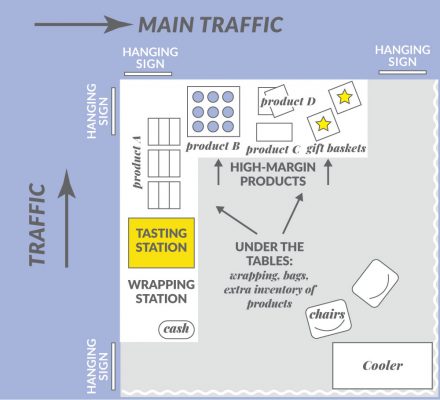 It’s useful to think of everything that you need to do at the booth: sampling, selling, and handling payments. You should also figure out how your team will circulate within the space to get extra inventory, process a credit card, wrap someone’s gift, or grab a bag.
It’s useful to think of everything that you need to do at the booth: sampling, selling, and handling payments. You should also figure out how your team will circulate within the space to get extra inventory, process a credit card, wrap someone’s gift, or grab a bag.
Also consider the height of your products, placing the higher ones at the back of the table. I am stating the obvious here!
Here is how we set up our booth at the Boston Christmas Festival. We had a corner booth which is obviously more expensive. We believe it is worth the extra cost though.
-
Offer gift packages
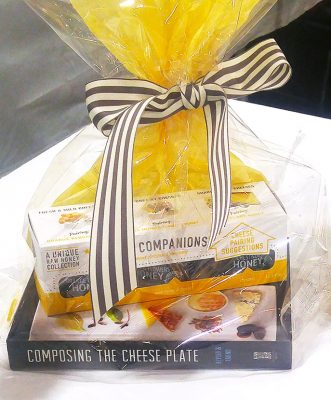 Offering gift wrapping (wrapping with bows and ribbons) is a great upselling opportunity. Make sure what you choose is easy and fast to assemble, because you’re going to be busy and will need to be quick!
Offering gift wrapping (wrapping with bows and ribbons) is a great upselling opportunity. Make sure what you choose is easy and fast to assemble, because you’re going to be busy and will need to be quick!
We had designed a “gift basket” made of a cheese board or a cheese book on which we could add other products, cheese knives, etc. and could quickly wrap with transparent paper and a ribbon. We had an example on display and sold a lot of those, for a small extra cost.
E. Other Logistics
OK, so you have your booth all planned. You’re almost there. There are just a few more logistics to deal with.
-
Specific requirements of the show
The show probably requires you to have a certificate of insurance. The Boston Christmas Festival also asked us to get a temporary local food license for Boston.
You also need to understand the rules for setting up and dismantling of your booth. In the case of the Boston Christmas Festival, they had a lot of rules. Each exhibitor had a precise time slot when they could bring their vehicle in the show area (parking alley). We could not only stay there for a short time and quickly carry all our stuff to the booth from there.
-
Inventory
Make a comprehensive list EARLY of everything you’ll need, e.g., canopy, products, samples, furniture, cooler, lights, bags and wrapping paper, electrical plugs (for phones, cooler, laptops and lights). That will help you plan for production and transportation.
-
Labor
You also need to estimate your labor needs, including set up, dismantle, and lunch breaks.
-
Transportation
As they say, “the devil is in the details.” Our experience proves the necessity to quickly understand what you’re bringing and, more importantly, how much space it will take.
For us, the Boston Christmas Festival was a 3-hour drive away. It was inconceivable to go back and forth, even if we ran out of some products during the show.
We quickly realized that our pickup was too small for everything we needed to bring and that we had to rent a trailer.
-
Payment methods
Square is an excellent service to be able to handle credit cards at a show. Just plug their little plastic square into your smartphone, open an account, provide your banking information, and you’re all set to take credit card payments. The money will be in your bank account the next day, and you’ll have elegant sales reports per product.
Be aware, however, that if there is no cell coverage or wifi at the show, you run the risk of a credit card payment being declined without your knowledge. The transactions will be processed once you get online access. Also, at the time we used it, there was no access to the emails customers provided. It was a disappointment as it would have been helpful to contact customers later.
You also need to be ready with lots of cash in small notes. We found that about 50% of our sales were cash and 50% credit cards.
-
Do a dry run
Last by not least: you’ve purchased all your display items (canopy, lights). I highly recommend that you build your booth with all the lights, and the merchandise on the display tables, in your warehouse or garage.
It’s too late, once at the show, to realize that there is an issue with your canopy, or that you don’t have enough space on your table!
It also helps to decide the best way to light the booth and the display.
OK, you’re finally ready for D day! That was quite a bit of work, but trust me, you won’t regret that you put the time to plan well.
F. Right After the Show
This is our last bit of advice. You just came back for an exhausting three days at the show. You have to catch up with a few things you’ve put aside while doing the last preparations for the show.
-
Debrief right after the show
Don’t delay writing a detailed debrief, while everything is still fresh in your mind. Write down what you learned, what went well, and what could be improved next time.
-
Do a Profit & Loss calculation
Capture all your costs and your sales per product to see which products were the most successful and if the show was a financial success (P&L).
Our experience was that the Boston Christmas Festival was a great show to go through a lot of inventory. We sold a lot in 3 days, but that costs were also high, from registration to lodging and transportation. It requires high revenues to make this festival profitable. Looking around us, I am not convinced that all exhibitors did. It depends highly on what you sell and how attractive your booth is.
Participating in such an event is also a considerable time investment, from the preparation, packing, traveling, to setting up, attending, and dismantling. You cannot ignore the opportunity cost of spending time on that show versus other uses of your time.
Can smaller shows, closer to home, with lower expenses and time commitment, be more cost-effective? It is hard to say. Expenses and revenues often seem to go hand in hand.
What are your thoughts? Do you have any experience exhibiting at Christmas Festivals that you want to share here?
